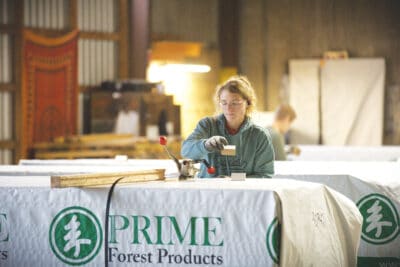Universities have become proving grounds for the adoption of mass timber in the United States, providing invaluable design and construction experience for firms, supplying an emerging buyer base for mass timber products, proving out financial benefits for stakeholders, and demonstrating the biophilic benefits conferred to those who live and learn in environments built with natural materials.
What makes universities so good at building with mass timber? One reason is that universities don’t face the intense ROI timelines that dictate commercial development, allowing leeway for resident academics to fully explore design ideas. Universities are also typically adept at securing the kind of supportive funding granted by the state, federal, and industry organizations that are trying to grow mass timber demand. It certainly also helps that some grants—such as the 2019 Mass Timber University Grant Program, administered by the USDA Forest Service—are aimed at universities. Lastly, academics tend to lean ideologically progressive on sustainability issues.
Prominent recent examples of campus mass timber projects include the University of Arkansas’s Adohi Hall, a 202,027-square-foot student residence constructed from cross-laminated timber (CLT); Oregon State’s Peavy Hall and the AA “Red” Emmerson Advanced Wood Products Laboratory, which feature CLT and glulam; Clemson University’s Andy Quattlebaum Outdoor Education Center, which ENR Southeast named best project in the sports and entertainment category in 2020; and the new dorm wing of Hanszen College at Rice University, which is to be built with CLT using Southern Yellow Pine.
“Universities have been acting as accelerators for mass timber construction,” notes Simon Hyoun, Senior Director of Education at the Softwood Lumber Board. “They prime the pump of commercialization and raise the level of professional expertise among the architect, engineer, and construction community.” Hyoun notes that the teaching effect of any innovative project is boosted in an academic setting, especially if the school offers study in the fields of architecture, engineering, or construction.
“Imagine a 20,000-square-foot materials lab built with mass timber where future architects are learning about designing with wood,” says Patricia Layton, Director of the Wood Utilization + Design Institute at Clemson. “You don’t have to imagine it. Universities and industry have been actively funding these types of projects—as well as the learning that happens within them.”
As manufacturing grows to meet increasing demand—1,303 mass timber projects have been completed or are in design as of late 2021, according to WoodWorks—universities can continue to play a leading role in expanding the mass timber market by demonstrating key concepts and training the workforce both in the classroom and on the project site.
To explore areas of collaboration, university programs should contact the SLB at info@softwoodlumberboard.org.









